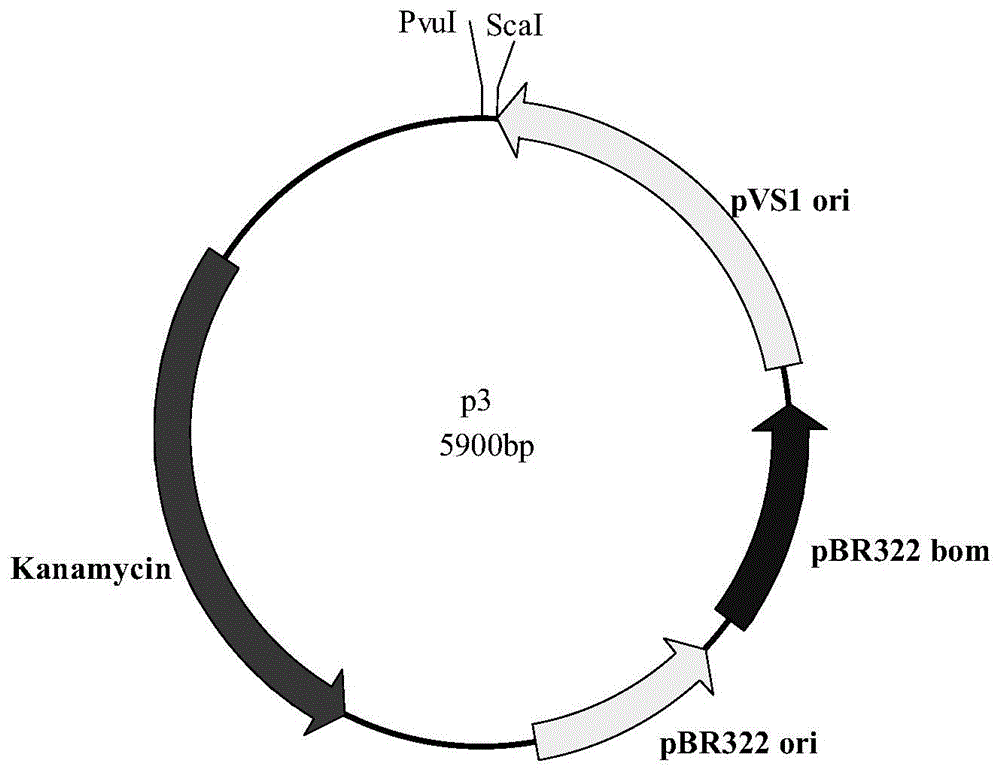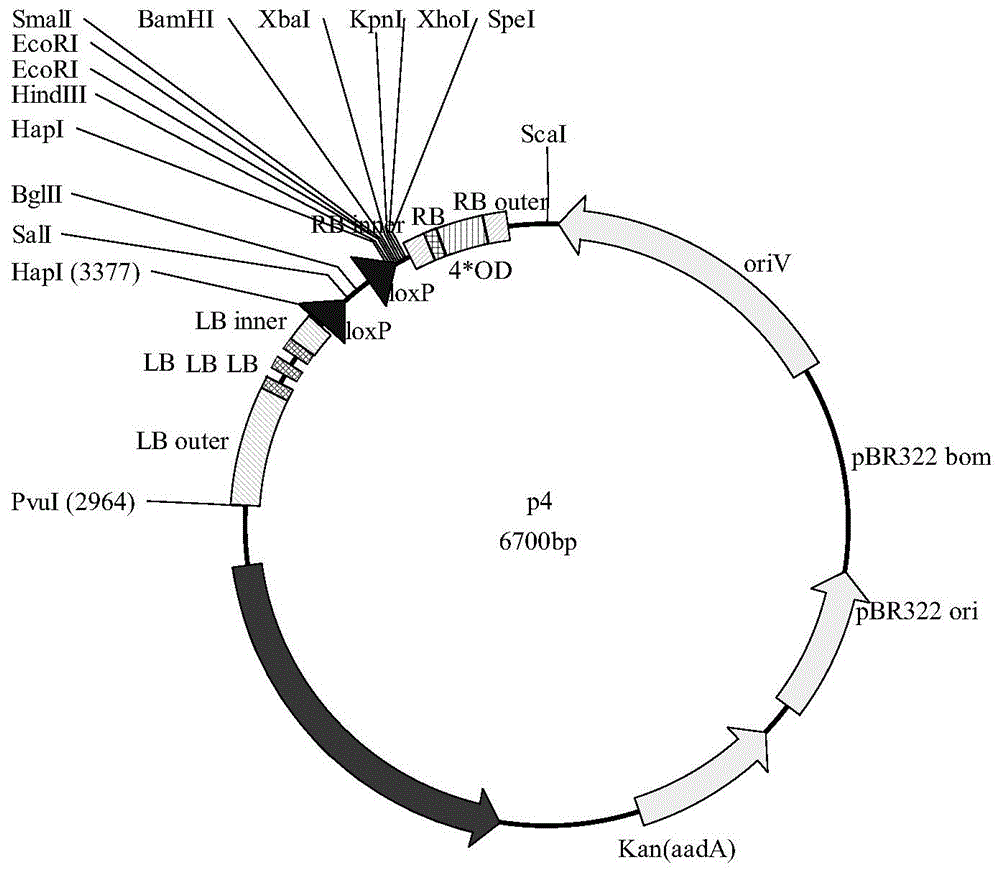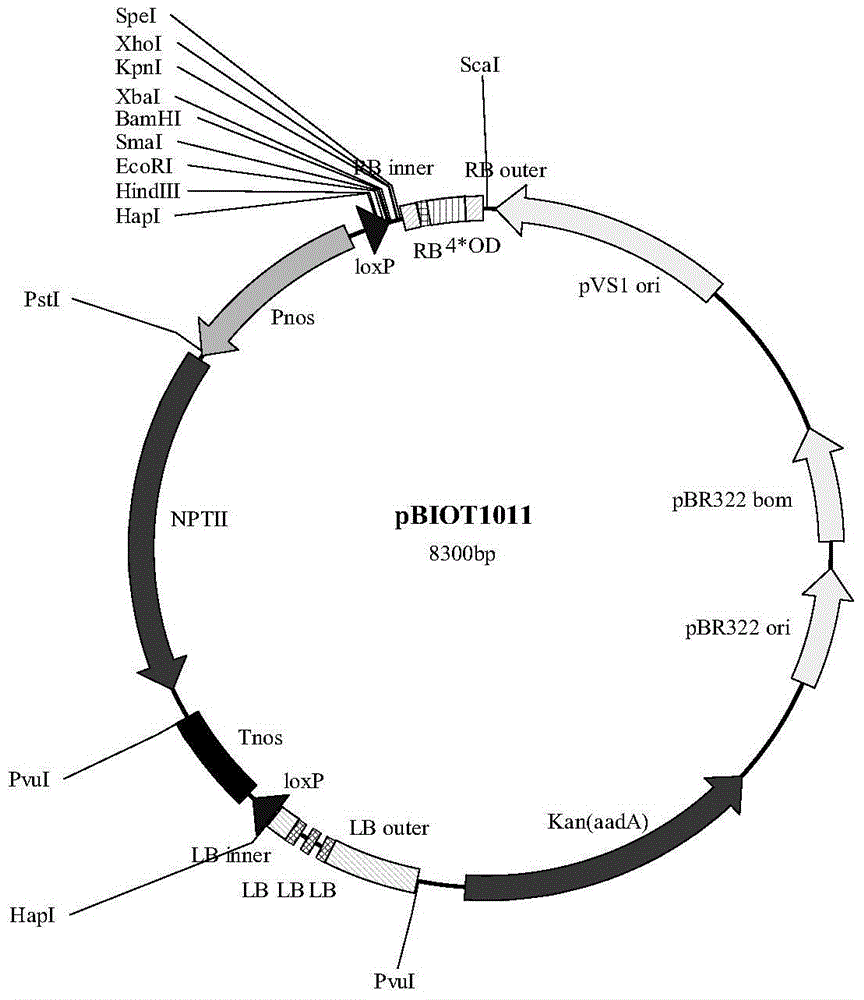Plant expression vector containing glyphosate resistant gene and application thereof
A glyphosate-resistant and expression vector technology, applied in the field of genetic engineering, can solve problems such as phytotoxicity, non-resistance to herbicides, and damage to cotton plants.
- Summary
- Abstract
- Description
- Claims
- Application Information
AI Technical Summary
Problems solved by technology
Method used
Image
Examples
Embodiment 1
[0028] Example 1 Bivalent mc2-epsps plant expression vector construction
[0029] Transformation of plant expression vector: Using pCAMBIA2300 (purchased from Beijing Dingguo Changsheng Biotechnology Co., Ltd.) as a template, amplify the sequence of the kanamycin resistance gene (aadA) to the plasmid replication origin (pVS1ori), at the 5' end EcoRI and PvuI restriction sites were added, ScaI and EcoRI restriction sites were added at the 3' end, the primer sequences were SEQ ID NO: 7 and SEQ ID NO: 8, and the amplified fragment was named Fragment A. Fragment A was digested with EcoRI enzyme, and vector p3 was obtained by self-circularization. Synthesize LB to RB end sequences, in order to increase the proportion of positive plants in genetic transformation, reduce the incidence of vector backbone DNA in the genome of transgenic plants, and increase the frequency of low-copy transformation events, modify the LB and RB ends, and add recognition cutting elements inside , adding ...
Embodiment 2
[0033] The acquisition of embodiment 2 transmutation bivalent mc2-epsps gene cotton
[0034] The Agrobacterium-mediated method used here is a plant genetic transformation method well known to those skilled in the art. The specific operation procedure is:
[0035] 1. Strain culture
[0036] The constructed plant expression vector of glyphosate-resistant gene was transformed into Agrobacterium strain LBA4404 by electric shock, and a single colony of Agrobacterium was inoculated in the culture medium containing 50 mg / L kanamycin (km), rifampicin (rifampicin, rif). 25mg / L of LB (tryptone 5g / L, yeast extract 5g / L, sodium chloride 10g / L, agar powder 15g / L) or YEB (beef extract 5g / L, yeast powder 1g / L, peptone 5g / L, sucrose 5g / L, MgSO 4 5ml / L) in liquid medium. Incubate overnight at 28°C in the dark with shaking to the logarithmic phase of bacterial growth. Dilute the bacterial solution with LB or YEB liquid medium, shake and culture for 4-6 hours, and dilute the bacterial solu...
Embodiment 3T0
[0049] Example 3 T0 Generation Transgenic Cotton Resistance Identification
[0050] After the grafting and transplanting of transgenic seedlings in Example 2 survived, spray 3000ppm glyphosate solution (glyphosate commercial preparation Roundup: Monsanto) in the 6-8 leaf stage, spray 45ml per square meter (i.e. 30L / mu) The symptoms were observed 7-14 days after each spraying, and the non-transgenic recipient material Jimian 14 was used as a negative control. 69 transformants of the transgenic cotton transformed with the bivalent mc2 gene showed resistance to glyphosate. Resistant plants were strictly self-pollinated. Due to the influence of tissue culture operations and greenhouse cultivation conditions, some of the resistant plants had poor fertility. 52 lines of T1 generation inbreds were received.
PUM
 Login to View More
Login to View More Abstract
Description
Claims
Application Information
 Login to View More
Login to View More - R&D
- Intellectual Property
- Life Sciences
- Materials
- Tech Scout
- Unparalleled Data Quality
- Higher Quality Content
- 60% Fewer Hallucinations
Browse by: Latest US Patents, China's latest patents, Technical Efficacy Thesaurus, Application Domain, Technology Topic, Popular Technical Reports.
© 2025 PatSnap. All rights reserved.Legal|Privacy policy|Modern Slavery Act Transparency Statement|Sitemap|About US| Contact US: help@patsnap.com



